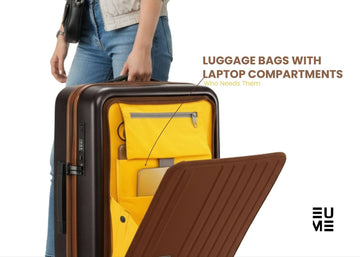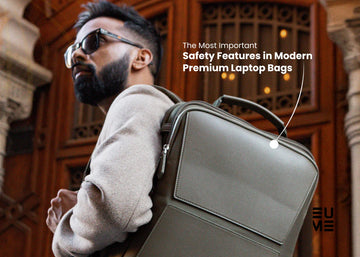Have you ever stood in an airport check-in queue or luggage aisle, unsure whether to pick a softshell cabin bag or a hardshell cabin bag?
Choosing the right luggage has quietly become one of the most important decisions a traveller makes. Cabin luggage isn’t just about storage anymore; it’s about ease, protection, and how smoothly you move through your journey.
As global travel continues to grow, the demand for the best cabin luggage has soared, and cabin bags are leading this growth. Travellers want lightweight, durable, and secure luggage that fits their lifestyle.
For those who want design, strength, and functionality wrapped into one, look for brands that offer both softshell and hardshell cabin bags that meet the needs of today’s frequent flyers.
What Is a Softshell Cabin Bag and Why Travellers Choose It
A softshell cabin bag is made with flexible fabrics such as ballistic nylon, canvas, or polyester. Travellers who prefer adaptability often go for this option because of how forgiving it is when it comes to space and storage.
Key benefits of softshell cabin bags:
-
A flexible build helps fit the bag into tight overhead bins without forcing it.
-
Lightweight construction means more allowance for personal belongings.
-
External pockets offer quick access to essentials like passports, chargers, or travel snacks.
-
Expandable compartments provide extra space for last-minute additions.
A softshell cabin bag works particularly well for weekend breaks, quick getaways, and city travel where mobility matters more than structure.
What Makes a Hardshell Cabin Bag a Strong Travel Companion
A hardshell cabin bag is made from rigid materials such as polycarbonate or polypropylene. Travellers carrying electronics, valuables, or fragile items often rely on its solid build for peace of mind.
Why many prefer hardshell cabin bags:
-
The sturdy shell keeps laptops, tablets, and fragile items well protected.
-
The waterproof exterior safeguards belongings in rainy weather.
-
A structured shape maintains its look even after repeated use.
-
TSA-approved locks add an extra layer of security.
A hardshell cabin bag suits business travellers, international flyers, and those who value maximum protection.
Softshell vs Hardshell Cabin Bag: Feature Comparison That Matters
|
Feature |
Softshell Cabin Bag |
Hardshell Cabin Bag |
|
Durability |
Withstands scuffs and scrapes well |
Strong impact resistance protects fragile items |
|
Flexibility |
Squeezes into overhead bins or small spaces |
Rigid and maintains shape |
|
Weight |
Lighter and easier to handle |
Slightly heavier but getting lighter with polycarbonate materials |
|
Water Resistance |
Offers moderate protection |
Excellent resistance to rain and spills |
|
Storage & Organisation |
Expandable and has exterior pockets |
Structured interior with clamshell opening |
|
Security |
Easier to unzip or breach |
TSA-approved locks and a rigid shell |
|
Appearance |
Casual, fabric look |
Sleek, modern finish |
|
Cleaning |
Can stain and needs more care |
Easy to wipe clean |
The choice ultimately comes down to travel habits. If you want flexibility, softshell cabin bags are practical. If you want security, hardshell cabin bags provide structure and protection.
How Softshell and Hardshell Cabin Bags Perform in Different Travel Scenarios
-
A softshell cabin bag works well for weekend trips where light packing is a priority.
-
A hardshell cabin bag is ideal for international flights and long-haul travel, offering sturdiness and security.
-
For homes with less storage, softshell luggage fits more easily into compact spaces.
-
If your journeys often involve rough handling or multiple connections, a hardshell option keeps your belongings safer.
Cabin Bag Security: Softshell vs Hardshell for Protection
Security plays a big role in choosing between softshell and hardshell cabin bags.
-
A hardshell cabin bag is usually fitted with integrated TSA-approved locks and a solid outer shell, making it far more tamper-resistant.
-
A softshell cabin bag relies on zippers and fabric, which can be more vulnerable but allow quicker access when travelling.
-
For those carrying valuables or electronics, a hardshell option offers better all-around protection.
Cabin Bag Weight Differences Every Traveller Should Know
Airlines typically allow between 7 and 10 kg of cabin luggage. That limit makes even a few hundred grams matter.
-
A softshell cabin bag often weighs less, giving more room for packing clothes, shoes, or other essentials.
-
A hardshell cabin bag has narrowed the gap thanks to lightweight polycarbonate designs.
For strict airline weight policies, a softshell cabin bag might give you the extra space you need without extra charges.
Which Cabin Bag Is Easier to Store and Carry
-
A softshell cabin bag can be folded or compressed slightly, making it easier to store under a bed or in a cupboard.
-
A hardshell cabin bag keeps its shape and takes up fixed space but offers solid protection.
For travellers living in smaller spaces or student accommodation, softshell options are often more practical.
Choosing the Right Cabin Bag for Your Travel Style
Different travellers have different priorities, and your luggage should reflect that.
-
For business travel, a hardshell cabin bag delivers a professional look and solid protection for electronics.
-
For family holidays, softshell options provide expandable space and easy access to essentials.
-
For solo or international travel, a hardshell bag offers added security.
-
For weekend getaways, a softshell bag keeps things light and flexible.
Why Premium Travel Luggage Materials Make a Difference
Materials shape how long your luggage lasts. Polycarbonate is prized for strength and impact absorption, while ballistic nylon is known for flexibility and resilience.
EUME uses high-grade travel luggage materials to ensure every trip is smooth. From 100% German Bayer polycarbonate hardshells to durable softshell fabric constructions, their bags are built to endure years of travel while staying stylish.
EUME, where strength meets design for modern travellers.
Final Verdict: Softshell vs Hardshell Cabin Bag Which Wins for You
The best cabin bag comparison depends entirely on your travel style. A softshell cabin bag gives flexibility, lightweight handling, and extra compartments. A hardshell cabin bag offers protection, security, and a premium feel.
Investing in the best cabin luggage makes every journey more comfortable, whether you’re heading for a quick weekend escape or an overseas adventure. Quality materials, smart design, and reliable performance always win.
EUME offers both softshell and hardshell cabin bags to suit every traveller. Find your perfect match for your next trip.
Shop EUME Cabin Bags https://eumeworld.com/
FAQS
1. Which lasts longer, softshell or hardshell cabin bags?
Hardshell cabin bags usually last longer because the rigid shell can withstand repeated impacts and rough airport handling. A well-made softshell cabin bag can still last several years with proper care, especially for light travellers who don’t check in their luggage.
2. Are hardshell cabin bags safer for electronics?
Yes. A hardshell cabin bag protects gadgets like laptops, tablets, and cameras by absorbing impact and keeping the shape intact. This makes it perfect for business trips or long-haul flights where delicate electronics need extra protection.
3. What are the weight differences between softshell and hardshell cabin bags?
A softshell cabin bag is usually lighter, giving more packing space under strict airline weight limits. Lightweight polycarbonate has reduced the gap for hardshell cabin bags, making both options manageable for frequent flyers.
4. Is softshell cabin luggage easier to store?
Yes. A softshell cabin bag compresses easily, fitting into tight wardrobes or under beds. This is particularly useful for people living in smaller flats or those who travel light and need flexible storage.
5. Which cabin bag is best for rough handling?
A hardshell cabin bag is better for rough handling because it resists crushing and protects items inside during transit. This is ideal for frequent flyers or those connecting through multiple flights.





















